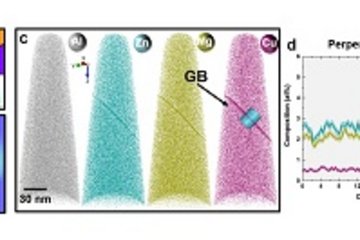All genres
1161.
Talk
Ab initio steel design: Achievements and challenges. Scientific Advisory Board Meeting 2009, MPI für Eisenforschung GmbH, Düsseldorf, Düsseldorf, Germany (2009)
1162.
Talk
Variations in the constructional morphology of crustacean skeletal elements at different hierarchical levels. Third International Conference on Mechanics of Biomaterials & Tissues ICMOBT 2009, Clearwater, FL, USA (2009)
1163.
Talk
Extremal stiffness of crustacean cuticle through hierarchical optimization: Experiments and modeling from ab initio to macroscale. PLASTICITY 2009, St. Thomas, Virgin Islands, USA (2009)
1164.
Talk
Polycrystal coarse graining of elastic properties for Ti-Nb biomedical grades using ab-initio single crystal elastic constants. International Plasticity Conference 2009, Virgin Islands, USA (2009)
1165.
Talk
Modeling of the mechanical properties of lobster cuticle from ab initio to macroscale: How nature designs multifunctional composites with optimal properties. International Plasticity Conference 2009, Virgin Islands, USA (2009)
1166.
Talk
Ab-initio simulation of hydrogen in metals. ICAMS Seminar, ICAMS Bochum, Germany (2008)
1167.
Talk
Atomic Structure and Elastic Anisotropy of Crystalline α-chitin: An Ab-initio Based Conformational Analysis. MRS Fall Conference 2008, Boston, MA, USA (2008)
1168.
Talk
Multiscale Prediction of Polycrystal Elastic Properties of Ultralight Weight Mg-Li Alloys using Ab Initio and FEM Approaches. MRS Fall Conference 2008, Boston, MA, USA (2008)
1169.
Talk
Ab inito study on elastic properties of Fe3Al-based alloys. MRS Fall Meeting 2008, Boston, MA, USA (2008)
1170.
Talk
Application of Spectral Methods for Anisotropy Design of Ti-Nb Polycrystals for Biomedical Applications based on ab Initio Elastic Single Crystal Constants and Fast Fourier Homogenization. MRS Fall Conference 2008, Boston, MA, USA (2008)
1171.
Talk
Ab-initio based growth simulations of GaN based nanowires. MRS fall meeting, Boston, MA, USA (2008)
1172.
Talk
Hierarchical Modeling of the Elastic Properties of Lobster Cuticle via Ab Initio Calculations and Mean-field Homogenization. MRS Fall Conference 2008, Boston, MA, USA (2008)
1173.
Talk
Ground-state structure and elastic anisotropy of crystalline alpha-chitin: An ab-initio based conformational analysis. Materials Research Society meeting (MRS), Boston, MA, USA (2008)
1174.
Talk
Multiscale Modelling of the Elastic Properties of Biological Polymer-Based Nanocomposites with Hierarchical Microstructure: The Lobster Cuticle. 3rd International Conference on Polymer Behaviour, Marrakech, Morocco (2008)
1175.
Talk
Ab initio based modeling of engineering materials: From a predictive thermodynamic description to tailored mechanical properties. Multiscale Materials Modeling 2008, Tallahassee, FL, USA (2008)
1176.
Talk
Understanding the phase transformations of the Ni2MnGa shape memory system. (2008)
1177.
Talk
Modeling of the strain-induced interaction between carbon atoms in Fe-C solid solution using embedded atom method potential. Contemporary Problems of Metal Physics, Kiev, Ukraine (2008)
1178.
Talk
Design of engineering materials based on ab initio thermodynamics and kinetics. Materials Science and Technology 2008, Pittsburgh, PA, USA (2008)
1179.
Talk
Ab initio study of Thermodynamics and adatom kinetics on non-polar GaN surfaces: Consequences on the growth morphology and the formation of nanowires. International Workshop on Nitride Semiconductors, Montreux, Switzerland (2008)
1180.
Talk
Ab initio based design of alloys. MS&T'08, Symposium: Discovery and Optimization of Materials Through Computational Design, David Lawrence Convention Center, Pittsburgh, PA, USA (2008)











